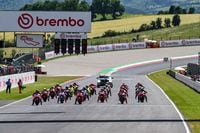
What-ifs are so much fun. The one I'm enjoying at the moment is Norton's planned liquid-cooled transverse Four, designed in the early 1950s by the same team that drew the 500-horsepower, 90-cubic-inch BRM V-16 Grand Prix car. If this date is right, design would have started at about the time it became known that Gilera was testing an air-cooled 500cc four-cylinder for GP racing.
All that came of the Norton project was a one-cylinder 125cc test engine and some castings for a prototype full-build engine. It's intriguing to consider the advanced techniques chosen and the engine's potential for power.
The probable designers were Peter Berthon, Eric Richter and Frank May. As for the V-16, they chose Vandervell three-layer plain journal bearings to support a one-piece forged steel crankshaft. One-piece construction would have eliminated all the backing-and-filling of the Italian four-cylinder builders, as they struggled to make some form of all-roller crankshaft reliable. Twelve thousand rpm? No problem.
Why did the BRM team choose journal bearings? Because the necessary know-how had been perfected through WW II on Merlin and Griffon V-12 aircraft engines.
The Norton's wet cylinder liners were screwed into the head, thereby eliminating the head gasket and the distorting force of the bolts providing gasket clamp load. At Guzzi, Ing. Carcano would screw his fabulous V8's liners into its heads in 1955. And today, screwed-in liners are considered an advanced technique in F1.
This engine was liquid-cooled. Big deal? A Norton Manx racing engine was chosen as a basis for the engine of an F1 car called the Vanwall. During testing, it was given a water jacket. Result? The water-cooled engine could steadily deliver 4 hp more than the air-cooled could give as a flash reading. Why? Because it could safely tolerate more compression.
British designers knew by 1950 that more compact combustion chambers with narrower valve angles burned faster, wasting less heat. The Norton-4 was drawn with a 60-degree valve included angle—not the 80-, 90- or even 100-degree included angles of the Italian fours, whose designs were inspired by 1930s auto racing engines.
The Norton-4 came to nothing because the company was faltering and R&D money was drying up. But imagine a 10,000-rpm 500cc four-cylinder with the same cylinder-filling ability as the Manx Single. The result would have been 75 hp, a power level not reached by the Italian fours until 1965! What if?
—Kevin Cameron
/cloudfront-us-east-1.images.arcpublishing.com/octane/4H4ATXAKEVAZ3J2PHP6YQTZDS4.jpg)
/cloudfront-us-east-1.images.arcpublishing.com/octane/Y3OL3X4UNNHTFAWAP6VKJZ5XYQ.jpg)
/cloudfront-us-east-1.images.arcpublishing.com/octane/IULKXHXNNBGHLA4N32I5IENJD4.jpg)
/cloudfront-us-east-1.images.arcpublishing.com/octane/MTNKDT6XFBAVTDCSTR33A5EAQY.jpg)
/cloudfront-us-east-1.images.arcpublishing.com/octane/GF43ABW66NDBZBEBCA2CY24EAI.jpg)
/cloudfront-us-east-1.images.arcpublishing.com/octane/4YSY335TXPUVXICZKUMMOSQ63A.jpg)
/cloudfront-us-east-1.images.arcpublishing.com/octane/A4EN3OE2HRBXVFICJ6K62CNXCM.jpg)
/cloudfront-us-east-1.images.arcpublishing.com/octane/ZBLIY3XNQ5ACNNJ65IL44KBZAE.jpg)
/cloudfront-us-east-1.images.arcpublishing.com/octane/HDO56KGQB5H25DJRM2J2PH2E5A.jpg)
/cloudfront-us-east-1.images.arcpublishing.com/octane/NZKPFUWBHVGYJAFQPCXWAK6BZM.jpg)
/cloudfront-us-east-1.images.arcpublishing.com/octane/K5ZSQFMYQZHWRFXTTW4PEWMUDM.jpg)
/cloudfront-us-east-1.images.arcpublishing.com/octane/D2SOSBIQQRBPTERNSOJRAW3KYY.jpg)
/cloudfront-us-east-1.images.arcpublishing.com/octane/DS3Q5X2VJFFAJDK2PWB3Y7K6U4.jpg)
/cloudfront-us-east-1.images.arcpublishing.com/octane/4KBL4JAMYRFDPEINTWATDUH7OM.jpg)
/cloudfront-us-east-1.images.arcpublishing.com/octane/FXADK3MVSNBRTKJ2B7TPDCCJ5Y.jpg)
/cloudfront-us-east-1.images.arcpublishing.com/octane/M7L2CPXO55FRFMECW7QGDPGP6E.jpg)
/cloudfront-us-east-1.images.arcpublishing.com/octane/T4RWGLAEHVE2VCJZOTFTNGB2KA.jpg)
/cloudfront-us-east-1.images.arcpublishing.com/octane/JM4QGLAHWNGHPM74OEB7FVBFSY.jpg)
/cloudfront-us-east-1.images.arcpublishing.com/octane/BGPNXPDDYBHD3HL6YEZQOYHXTI.jpg)
/cloudfront-us-east-1.images.arcpublishing.com/octane/SND5GGQV4RDPPMZBSBEGIZ4SIY.jpg)
/cloudfront-us-east-1.images.arcpublishing.com/octane/XUDDAPYZMZEL5EDPVDJ2DTULWI.jpg)
/cloudfront-us-east-1.images.arcpublishing.com/octane/M7AU2L6GAVCJVHW57LIRPDAAUQ.jpg)

/cloudfront-us-east-1.images.arcpublishing.com/octane/JKEJY7P43JGD5C5NJO2VJQJPUM.jpg)